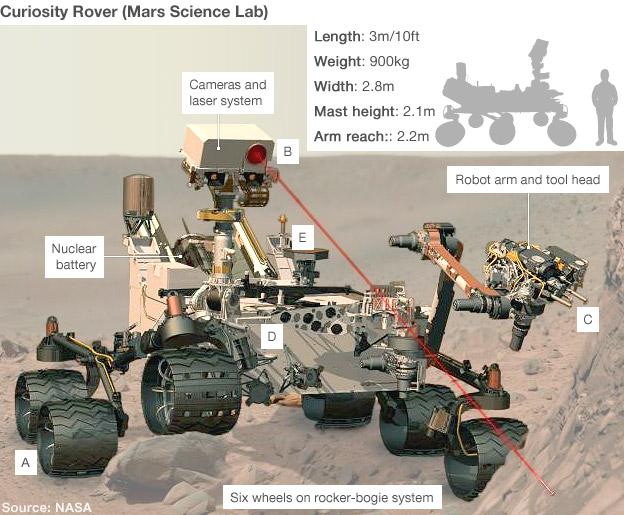Mars rover examines rock close up
- Published

The rover's arm manoeuvres the "hand lens" and X-ray spectrometer close to the pyramidal rock
Nasa's Curiosity rover has completed its first close-contact science.
The robot pushed its arm instruments up against a pyramidal rock to assess the atomic elements that were present.
The rock - dubbed "Jake Matijevic, external" after a late rover engineer - was not expected to have high research value. Rather, it was regarded as an early opportunity to demonstrate the performance of the arm's "hand lens" and X-ray spectrometer.
Curiosity, external has now continued driving.
On Monday, it moved some 42m (138ft), the single biggest roll for the robot since landing seven weeks ago in Mars' equatorial Gale Crater.
The vehicle is endeavouring to get to a location that scientists have nicknamed Glenelg, which satellite images have indicated is a junction between three types of geological terrain.
It is at Glenelg that Curiosity will likely use one of its key arm tools - its drill - for the first time.
Even before the rover gets to the junction, it will look for some suitable soil to scoop and deliver to its onboard laboratories for analysis.
Nasa's $2.6bn mission touched down on the Red Planet on 6 August (GMT).
Much of the time since then has been spent commissioning the immensely complex, six-wheeled machine and its suite of 10 instruments.
The Jake Matijevic investigation allowed the science team to use the X-ray spectrometer (APXS, external) and the hand lens (Mahli, external) in unison with the rover's infrared laser instrument (ChemCam, external).
The laser, which sits atop the rover's mast, also determines the chemical composition of targets, and the rock experiment meant researchers could do some cross-calibration of APXS and ChemCam.
Little information has been released by Nasa about what it saw, but then the pyramidal rock was not expected to be anything more than a standard lump of Martian basalt.
As the mission progresses, APXS and ChemCam, along with the keen eye of Mahli, will be used to survey the crater's surface for more interesting rocks. When they identify a fascinating target, it is at that point that the drill will be commanded to acquire a sample for detailed scrutiny in the onboard , externallaboratories, external.
Curiosity's mission has been funded for one Martian year (two Earth years) of study. It will try to determine in that time whether past environments at Gale Crater could ever have supported microbial life.

(A) Curiosity will trundle around its landing site looking for interesting rock features to study. Its top speed is about 4cm/s
(B) This mission has 17 cameras. They will identify particular targets, and a laser will zap those rocks to probe their chemistry
(C) If the signal is significant, Curiosity will swing over instruments on its arm for close-up investigation. These include a microscope
(D) Samples drilled from rock, or scooped from the soil, can be delivered to two hi-tech analysis labs inside the rover body
(E) The results are sent to Earth through antennas on the rover deck. Return commands tell the rover where it should drive next
Jonathan.Amos-INTERNET@bbc.co.uk and follow me on Twitter: @BBCAmos, external
- Published20 September 2012
- Published18 September 2012
- Published12 September 2012
- Published10 September 2012
- Published30 August 2012
- Published28 August 2012
- Published22 August 2012
- Published20 August 2012
- Published20 August 2012
- Published17 August 2012
- Published9 August 2012
- Published6 August 2012
- Published4 August 2012